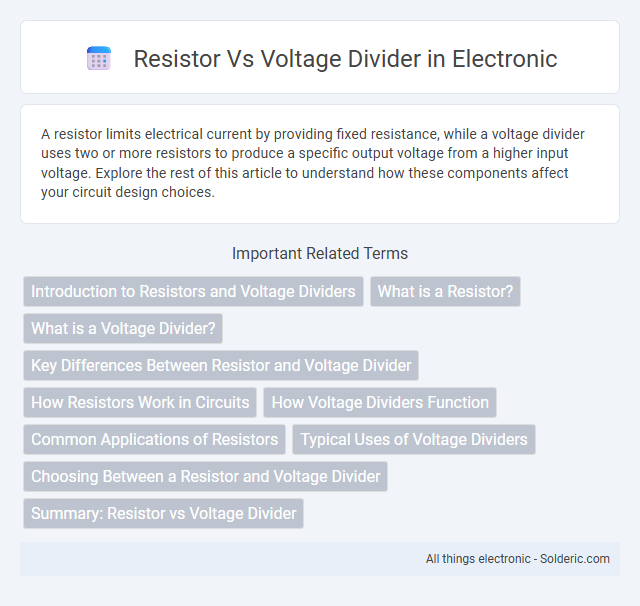A resistor limits electrical current by providing fixed resistance, while a voltage divider uses two or more resistors to produce a specific output voltage from a higher input voltage. Explore the rest of this article to understand how these components affect your circuit design choices.
Comparison Table
| Feature | Resistor | Voltage Divider |
|---|---|---|
| Definition | Passive electrical component that resists current flow. | Circuit of two or more resistors that divides input voltage. |
| Primary Function | Limit current and drop voltage. | Provide a specific fraction of input voltage as output. |
| Configuration | Single component. | Series connection of resistors. |
| Output Voltage | Voltage drop depends on current and resistance (Ohm's Law). | Precise fraction of input voltage based on resistor ratio. |
| Usage | Current limiting, biasing, signal conditioning. | Voltage scaling, sensor interfacing, reference voltage generation. |
| Design Complexity | Simple, single part. | Requires calculation of resistor values for desired ratio. |
| Example | 1 kO resistor. | Two resistors forming 5V from 12V supply. |
Introduction to Resistors and Voltage Dividers
Resistors are fundamental electronic components that limit current flow and adjust signal levels in circuits. A voltage divider is a simple resistive circuit configuration that produces a specific output voltage based on the ratio of two resistors. Understanding how your voltage divider uses resistors enables precise control of voltage in various electronic applications.
What is a Resistor?
A resistor is a passive electrical component that limits or regulates the flow of electric current in a circuit by providing a specific amount of resistance measured in ohms (O). Unlike a voltage divider, which uses multiple resistors to produce a desired output voltage, a single resistor's primary function is to control current and protect components from damage. When designing your circuit, understanding the resistor's role is essential for managing voltage and current effectively.
What is a Voltage Divider?
A voltage divider is an electrical circuit that uses two or more resistors to produce a specific output voltage lower than the input voltage. It operates on the principle of voltage drop across resistors connected in series, enabling precise control of output voltage for various electronic applications. This simple yet essential circuit is fundamental in sensor interfacing, signal conditioning, and adjusting voltage levels within complex systems.
Key Differences Between Resistor and Voltage Divider
Resistors are individual components that limit current flow or reduce voltage in a circuit, while a voltage divider is a specific arrangement of two or more resistors designed to produce a desired output voltage from a higher input voltage. The key difference lies in their function: a resistor provides a fixed resistance value, whereas a voltage divider provides a proportional voltage output based on the ratio of its resistors. Understanding your circuit requirements helps determine whether a single resistor or a voltage divider is needed for accurate voltage control.
How Resistors Work in Circuits
Resistors control the flow of electric current by providing a specific amount of resistance, measured in ohms, which limits current according to Ohm's Law (V = IR). In voltage divider circuits, resistors are arranged in series to create different voltage levels from a single power source, allowing precise voltage control for components. Understanding resistor values and power ratings is crucial for designing effective voltage dividers that ensure stable and accurate voltage outputs.
How Voltage Dividers Function
Voltage dividers function by using two resistors connected in series to produce a specific fraction of the input voltage as output. The output voltage is determined by the ratio of the resistors' resistance values according to the formula V_out = V_in * (R2 / (R1 + R2)). This simple circuit is essential for adjusting voltage levels to match the requirements of various electronic components.
Common Applications of Resistors
Resistors are fundamental components used to limit current, adjust signal levels, and protect circuits in various electronic devices, including power supplies, audio equipment, and sensors. Voltage dividers, which consist of two or more resistors, are commonly applied to create reference voltages, reduce voltage levels for analog-to-digital converters, and measure sensor outputs with precision. Understanding your circuit's requirements ensures proper resistor selection to optimize performance and reliability.
Typical Uses of Voltage Dividers
Voltage dividers are commonly used to scale down high voltage levels to lower, more manageable voltages for sensors, microcontrollers, and other electronic components. They provide precise reference voltages for analog-to-digital conversion and signal conditioning in various circuits. You can rely on voltage dividers for tasks like adjusting input signal levels and biasing transistors in audio, measurement, and control systems.
Choosing Between a Resistor and Voltage Divider
Choosing between a resistor and a voltage divider depends on the required voltage regulation and power dissipation in the circuit. A single resistor is ideal for current limiting or simple load applications, while a voltage divider, made of two resistors, provides a specific reduced voltage output by splitting the input voltage proportionally. For precise voltage control and lower power loss, voltage dividers are preferred, but resistor-only configurations are simpler and consume less space.
Summary: Resistor vs Voltage Divider
A resistor is a passive electrical component that restricts current flow by providing a specific amount of resistance, measured in ohms. A voltage divider consists of two or more resistors configured in series to produce a desired output voltage that is a fraction of the input voltage. You can use a resistor alone to limit current, but a voltage divider is essential when you need a precise lower voltage from a higher voltage source for circuits and sensors.
resistor vs voltage divider Infographic

 solderic.com
solderic.com